Manual
- Unity User Manual (2018.2)
- Working in Unity
- Getting Started
- Unity Hub
- Installing Unity using the Hub
- Adding components to the Unity Editor
- Installing Unity without the hub
- Installing Unity offline without the Hub
- Unity Hub advanced deployment considerations
- 2D или 3D проекты
- Project Templates
- Starting Unity for the first time
- Opening existing Projects
- Learning the interface
- Asset Workflow (работа с ассетами)
- The Main Windows
- Создание геймплея.
- Editor Features
- Advanced Development
- Advanced Editor Topics
- Licenses and Activation
- Upgrade Guides
- Использование автоматического обновления API
- Upgrading to Unity 2018.2
- Upgrading to Unity 2018.1
- Upgrading to Unity 2017.3
- Upgrading to Unity 2017.2
- Upgrading to Unity 2017.1
- Upgrading to Unity 5.6
- Upgrading to Unity 5.5
- Upgrading to Unity 5.4
- Upgrading to Unity 5.3
- Upgrading to Unity 5.2
- Upgrading to Unity 5.0
- Руководство по обновлению до Unity 4.0
- Обновление до Unity 3.5
- Getting Started
- Importing
- 2D
- Графика
- Обзор графических возможностей
- Освещение
- Lighting overview
- Lighting Window
- Light Explorer
- Light sources
- Shadows
- Global Illumination
- Enlighten
- Progressive Lightmapper
- Lightmap Parameters
- Baked ambient occlusion
- LOD for baked lightmaps
- Light Probes
- Reflection probes
- Lighting Modes
- GI visualizations in the Scene view
- Lighting Data Asset
- Lightmap Directional Modes
- Lightmaps: Technical information
- Material properties and the GI system
- Global Illumination UVs
- GI cache
- Light troubleshooting and performance
- Related topics
- Камеры
- Materials, Shaders & Textures
- Текстуры
- Creating and Using Materials
- Standard Shader
- Standard Particle Shaders
- Physically Based Rendering Material Validator
- Accessing and Modifying Material parameters via script
- Writing Shaders
- Legacy Shaders
- Video overview
- Ландшафтный движок
- Tree Editor
- Системы Частиц
- Post-processing overview
- Расширенные возможности рендеринга
- Procedural Mesh Geometry
- Оптимизация производительности графики
- Слои
- Освещение
- Справка по графическим возможностям
- Справочник по камерам
- Shader Reference
- Writing Surface Shaders
- Программирование вершинных и фрагментных (пиксельных) шейдеров
- Примеры вершинных и фрагментных шейдеров
- Shader semantics
- Accessing shader properties in Cg/HLSL
- Providing vertex data to vertex programs
- Встроенные подключаемые файлы для шейдеров
- Стандартные шейдерные предпроцессорные макросы
- Built-in shader helper functions
- Built-in shader variables
- Создание программ с несколькими вариантами шейдеров
- GLSL Shader programs
- Shading Language used in Unity
- Shader Compilation Target Levels
- Shader data types and precision
- Using sampler states
- Синтаксис ShaderLab: Shader
- Синтаксис ShaderLab: свойства
- Синтаксис ShaderLab: SubShader
- Синтаксис ShaderLab: Pass
- ShaderLab: Culling & Depth Testing
- Синтаксис ShaderLab: Blending
- Синтаксис ShaderLab: тэги Pass
- Синтаксис ShaderLab: Stencil
- Синтаксис ShaderLab: Name
- Синтаксис ShaderLab: цвет, материал, освещение
- ShaderLab: Legacy Texture Combiners
- Синтакс ShaderLab: Альфа тестинг (Alpha testing)
- Синтаксис ShaderLab: туман
- Синтаксис ShaderLab: BindChannels
- Синтаксис ShaderLab: UsePass
- Синтаксис ShaderLab: GrabPass
- ShaderLab: SubShader Tags
- Синтаксис ShaderLab: Pass
- Синтаксис ShaderLab: Fallback
- #Синтаксис ShaderLab: CustomEditor
- Синтаксис ShaderLab: другие команды
- Shader assets
- Расширенные возможности ShaderLab
- Unity's Rendering Pipeline
- Performance tips when writing shaders
- Rendering with Replaced Shaders
- Custom Shader GUI
- Использование текстур глубины
- Текстура глубины камеры
- Особенности рендеринга различных платформ
- Уровень детализации шейдера (Level Of Detail)
- Texture arrays
- Debugging DirectX 11/12 shaders with Visual Studio
- Debugging DirectX 12 shaders with PIX
- Implementing Fixed Function TexGen in Shaders
- Particle Systems reference
- Particle System
- Particle System modules
- Particle System Main module
- Emission module
- Particle System Shape Module
- Velocity over Lifetime module
- Noise module
- Limit Velocity Over Lifetime module
- Inherit Velocity module
- Force Over Lifetime module
- Color Over Lifetime module
- Color By Speed module
- Size over Lifetime module
- Size by Speed module
- Rotation Over Lifetime module
- Rotation By Speed module
- External Forces module
- Collision module
- Triggers module
- Sub Emitters module
- Texture Sheet Animation module
- Lights module
- Trails module
- Custom Data module
- Renderer module
- Системы частиц (Более старая система, используемая до версии 3.5)
- Справка по Визуальным Эффектам
- Mesh Components
- Текстурные компоненты
- Компоненты рендеринга
- Rendering Pipeline Details
- Подборка уроков по графике
- How do I Import Alpha Textures?
- Как я могу создать Skybox?
- Как сделать эмиттер частиц в форме меша (Устаревшая система частиц)
- Как добавить Spot Light Cookie (Cookie текстура для Точечного Источника Света)?
- Как мне исправить вращение импортированной модели?
- Water in Unity
- Art Asset best practice guide
- Importing models from 3D modeling software
- How to do Stereoscopic Rendering
- Уроки по графике
- Scriptable Render Pipeline
- Обзор графических возможностей
- Physics
- Скриптинг
- Обзор Скриптинга
- Создание и Использование Скриптов
- Variables and the Inspector
- Controlling GameObjects using components
- Функции событий
- Time and Framerate Management
- Создание и уничтожение игровых объектов (GameObjects)
- Coroutines
- Пространства имён
- Attributes
- Порядок выполнения функций событий
- Понимание автоматического управления памятью
- Platform dependent compilation
- Специальные папки и порядок компиляции скриптов
- Script compilation and assembly definition files
- .NET profile support
- Referencing additional class library assemblies
- Stable scripting runtime: known limitations
- Generic Functions
- Scripting restrictions
- Script Serialization
- Unity События (UnityEvents)
- What is a Null Reference Exception?
- Important Classes
- Рецепты использования векторов
- Инструменты Скриптинга
- Система событий (EventSystem)
- C# Job System
- Обзор Скриптинга
- Multiplayer and Networking
- Multiplayer Overview
- Setting up a multiplayer project
- Using the Network Manager
- Using the Network Manager HUD
- The Network Manager HUD in LAN mode
- The Network Manager HUD in Matchmaker mode
- Converting a single-player game to Unity Multiplayer
- Debugging Information
- The Multiplayer High Level API
- Multiplayer Component Reference
- Multiplayer Classes Reference
- UnityWebRequest
- Аудио
- Аудио. Обзор.
- Аудио файлы
- Трекерные модули
- Audio Mixer
- Native Audio Plugin SDK
- Audio Profiler
- Ambisonic Audio
- Справочник по аудио
- Audio Clip
- Audio Listener
- Audio Source
- Audio Mixer
- Аудио эффекты (только для Pro версии)
- Audio Effects
- Audio Low Pass Effect
- Audio High Pass Effect
- Audio Echo Effect
- Audio Flange Effect
- Audio Distortion Effect
- Audio Normalize Effect
- Audio Parametric Equalizer Effect
- Audio Pitch Shifter Effect
- Audio Chorus Effect
- Audio Compressor Effect
- Audio SFX Reverb Effect
- Audio Low Pass Simple Effect
- Audio High Pass Simple Effect
- Reverb Zones
- Микрофон
- Audio Settings
- Анимация
- Animation System Overview
- Анимационные клипы
- Animator Controllers (контроллеры аниматоров)
- Аниматор и контроллер аниматора
- The Animator Window
- Конечные автоматы в анимации
- Blend Trees (Деревья смешивания)
- Применение Blend Shapes (форм смешивания) для анимации
- Animator Override Controllers
- Переназначение гуманоидных анимаций
- Performance and optimization
- Animation Reference
- Кривые анимации и события
- Playables API
- Словарь терминов анимации и Mecanim.
- Timeline
- Пользовательский интерфейс
- Сanvas (Полотно)
- Basic Layout
- Визуальные компоненты
- Компоненты взаимодействия
- Animation Integration
- Auto Layout
- «Обогащенный» текст (Rich Text)
- Справка по пользовательским интерфейсам
- Практические рекомендации по работе с UI (пользовательскими интерфейсами)
- Immediate Mode GUI (IMGUI)
- Навигация и поиск пути
- Navigation Overview
- Navigation System in Unity
- Inner Workings of the Navigation System
- Building a NavMesh
- NavMesh building components
- Advanced NavMesh Bake Settings
- Creating a NavMesh Agent
- Creating a NavMesh Obstacle
- Creating an Off-mesh Link
- Building Off-Mesh Links Automatically
- Building Height Mesh for Accurate Character Placement
- Navigation Areas and Costs
- Loading Multiple NavMeshes using Additive Loading
- Using NavMesh Agent with Other Components
- Справочник по навигации
- Navigation How-Tos
- Navigation Overview
- Unity Services
- Setting up your project for Unity Services
- Unity Organizations
- Unity Ads
- Unity Analytics
- Unity Analytics Overview
- Setting Up Analytics
- Analytics Dashboard
- Analytics events
- Funnels
- Remote Settings
- Unity Analytics A/B Testing
- Monetization
- User Attributes
- Unity Analytics Raw Data Export
- Data reset
- Upgrading Unity Analytics
- COPPA Compliance
- Unity Analytics and the EU General Data Protection Regulation (GDPR)
- Analytics Metrics, Segments, and Terminology
- Unity Cloud Build
- Automated Build Generation
- Supported platforms
- Supported versions of Unity
- Version control systems
- Using the Unity Developer Dashboard to configure Unity Cloud Build for Git
- Using the Unity Editor to configure Unity Cloud Build for Git
- Using the Unity Developer Dashboard to configure Unity Cloud Build for Mercurial
- Using the Unity Editor to configure Unity Cloud Build for Mercurial
- Using Apache Subversion (SVN) with Unity Cloud Build
- Using the Unity Developer Dashboard to configure Unity Cloud Build for Perforce
- Using the Unity Editor to configure Unity Cloud Build for Perforce
- Building for iOS
- Advanced options
- Build manifest
- Cloud Build REST API
- Unity IAP
- Setting up Unity IAP
- Cross Platform Guide
- Codeless IAP
- Defining products
- Subscription Product support
- Initialization
- Browsing Product Metadata
- Initiating Purchases
- Processing Purchases
- Handling purchase failures
- Restoring Transactions
- Purchase Receipts
- Receipt validation
- Store Extensions
- Cross-store installation issues with Android in-app purchase stores
- Store Guides
- Implementing a Store
- IAP Promo
- Unity Collaborate
- Setting up Unity Collaborate
- Adding team members to your Unity Project
- Viewing history
- Enabling Cloud Build with Collaborate
- Managing Unity Editor versions
- Reverting files
- Resolving file conflicts
- Excluding Assets from publishing to Collaborate
- Publishing individual files to Collaborate
- Restoring previous versions of a project
- In-Progress edit notifications
- Managing cloud storage
- Moving your Project to another version control system
- Collaborate troubleshooting tips
- Unity Cloud Diagnostics
- Unity Integrations
- Multiplayer Services
- XR
- XR SDKs
- Google VR
- Vuforia
- Windows Mixed Reality
- Unity XR input
- XR API reference
- Mixed Reality Devices
- Обзор
- VR devices
- Single Pass Stereo rendering (Double-Wide rendering)
- VR Audio Spatializers
- XR SDKs
- Open-source repositories
- Asset Store Publishing
- Специфичные платформы
- Автономный
- macOS
- Apple TV
- WebGL
- WebGL Player Settings
- Getting started with WebGL development
- WebGL Browser Compatibility
- Building and running a WebGL project
- WebGL: Deploying compressed builds
- Debugging and troubleshooting WebGL builds
- WebGL Graphics
- WebGL Networking
- Using Audio In WebGL
- WebGL performance considerations
- Memory in WebGL
- WebGL: Interacting with browser scripting
- Using WebGL Templates
- Cursor locking and full-screen mode in WebGL
- Input in WebGL
- iOS
- Первые шаги в iOS разработке
- iOS Player Settings
- iOS 2D Texture Overrides
- Upgrading to 64-bit iOS
- Продвинутые темы по iOS
- Features currently not supported by Unity iOS
- Решение проблем на iOS устройствах
- Сообщение об ошибках, приводящих к "падениям" на iOS
- Android
- Getting started with Android development
- Android environment setup
- Unity Remote
- Android Remote (УСТАРЕВШЕЕ)
- Troubleshooting Android development
- Building apps for Android
- Reporting crash bugs under Android
- Support for APK expansion files (OBB)
- Написание кода для Android
- Building and using plug-ins for Android
- Кастомизация экрана приветствия (Splash Screen) на Android
- Single-Pass Stereo Rendering for Android
- Android Player Settings
- Android 2D Textures Overrides
- Gradle for Android
- Android Manifest
- Getting started with Android development
- Windows
- Windows General
- Universal Windows Platform
- Приложения Windows Store: Приступая к работе
- Universal Windows Platform: Deployment
- Universal Windows Platform: Profiler
- Universal Windows Platform: Command line arguments
- Universal Windows Platform: Association launching
- Класс AppCallbacks
- Universal Windows Platform: WinRT API in C# scripts
- Universal Windows Platform Player Settings
- Scripting Backends
- ЧаВо
- Universal Windows Platform: Examples
- Universal Windows Platform: Code snippets
- Known issues
- Web Player
- Чеклист Мобильного Разработчика
- Experimental
- Legacy Topics
- Best practice guides
- Expert guides
- New in Unity 2018.2
- Packages Documentation
- Glossary
- Unity User Manual (2018.2)
- Unity Services
- Unity Analytics
- Unity Analytics Overview
Unity Analytics Overview
Unity Analytics provides the data you need to manage your relationship with your players.
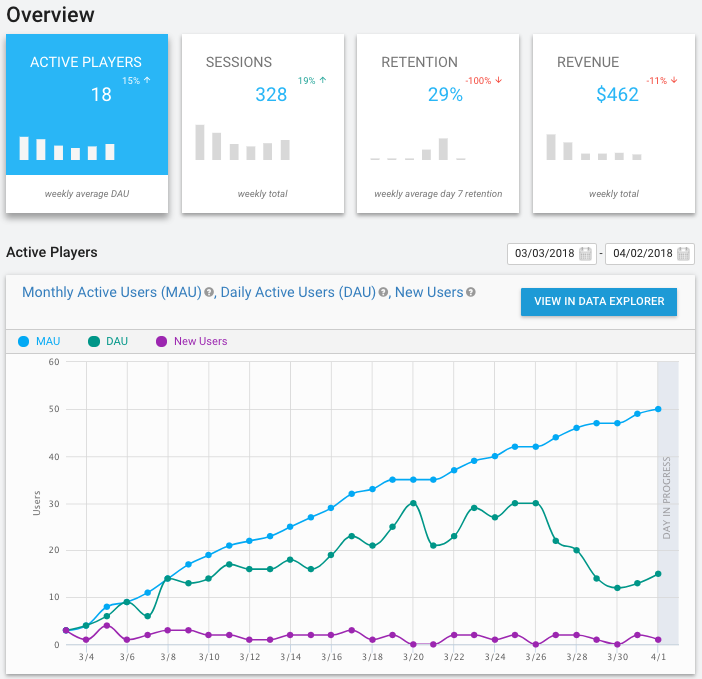
Understand your players; understand why they play your games; understand why they stop playing your games. Make decisions based on data, not guesses.
By simply enabling Unity Analytics in your project, you can get data about how many people first start playing your game, how many play every day, how many play in a given month, and other session-based usage data. If you also use the Unity Ads and IAP Services, your analytics data automatically includes the revenue from these sources. This sort of session data paints a valuable picture of the health of your game. It answers question such as: “Am I getting new players?” “How often and how long do they play?” “Do they play again the next day? The next week? The next month?” “How much revenue am I making per player on a given day?”
By dispatching Standard Analytics Events when players perform key actions in your game, you can extend the analytics data available so that it reveals what your players are actually doing when they play. Do they make it through your onboarding tutorial? Do they visit your IAP store? Do they progress through your game levels as you expect?
Analytics data can help you focus on the most fruitful areas to improve your application to better serve your players. You can make these changes by releasing updates, but you can also create Remote Settings that allow you to adapt and tune your game without an update.
By understanding your players and how they play your games, you can make your games better. And when the data shows that your players are changing, you can react and adapt.
See Analytics Metrics, Segments, and Terminology for definitions of specific terms used throughout the Analytics documentation.
Core usage data
When you enable Analytics, Unity tracks core usage metrics on supported platforms without any effort or implementation on your part. These core metrics include:
- New installs
- Daily active users (DAU)
- Monthly active users (MAU)
- Total sessions
- Sessions per user
- Time spent in app
- User Segments for Country and Platform
These are all good metrics to use to monitor the health of your game. They tell you how many people are installing your game, how often they play, and how long they stick with it. Many external factors also influence these numbers, but you should watch them for signs of problems that you can correct.
The following chart, displayed on the Overview tab of your Analytics Dashboard shows three data plots: New Users, DAU (Daily Active Users), and MAU (Monthly Active Users):
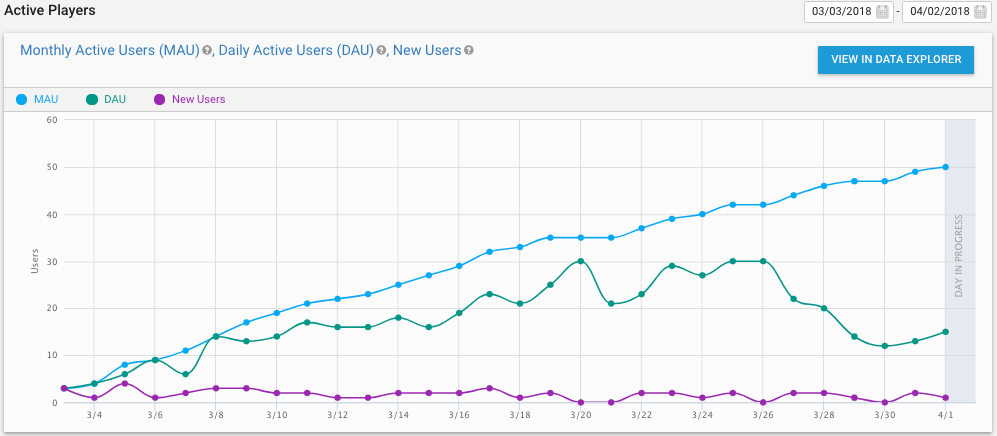
The New Users plot shows how many people play your game for the first time on a given day. Since new players won’t have had much, if any, exposure to your game, this chart generally reflects external factors. If you launch a marketing campaign or other promotion to attract new players, you would hope to see a bump in the New Users plot.
The DAU plot shows how many of your players played on a given day. Similar to the DAU plot, the MAU plot shows how many of your players played in a given 30-day period.
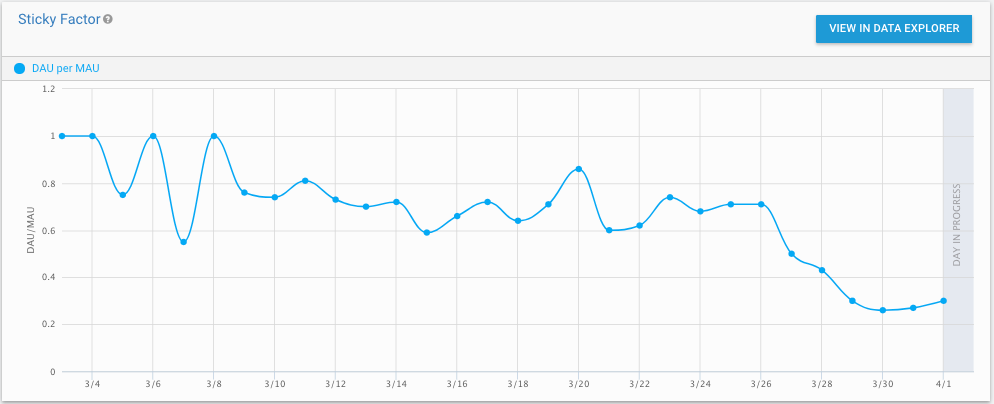
The Sticky Factor chart plots the percentage of your monthly players who played on a given day (DAU/MAU). The general idea behind this metric is that it shows how often your players return to play day-after-day. (In other words, how likely players are to “stick” with your game.)
High active player numbers can indicate popularity, but can be tricky to interpret in isolation. In particular, these metrics don’t separate the influence of new versus returning users. For example, an influx of new players could mask the loss of more established players. (The loss of players is called “churn” in common analytics jargon.) DAU, MAU, and Sticky Factor metrics are often used in the Games industry because DAU and MAU have historically been the most widespread publically-available data with which to compare different games.
See Analytics Dashboard for information on how to view your analytics data.
Player behavior data
To learn about game-specific player behavior, you can send analytics events from your game at the appropriate times. Unity provides easy-to-use APIs for sending both standardized and fully-customized events. You can use these events to instrument your games to monitor player behavior, particularly in the following areas:
- Onboarding — are players making it through your onboarding mechanics such as tutorials or starting levels?
- Progression — are players progressing through your levels?
- Economy — are your game economies working out as expected?
- Design validation — are your game design choices working out as you thought they would?
- Application validation — are all areas of your application being utilized as you expect? Are there parts that players ignore or don’t notice?
- Monetization — are your monetization strategies optimal? Are there impediments to players carrying out purchases?
See Analytics Events for information on gathering player behavior data.
To help you analyze player behavior, the Analytics Dashboard includes a funnel builder. A funnel is a display that shows how your players progress through a linear sequence of steps. For example, you could create a funnel for a tutorial that showed what percentage of your users made it through the tutorial steps. Funnels are useful for identifying places in your application where you lose players.

This example funnel shows player progression through a hypothetical game. Each step in the funnel represents the completion of a game level. While you can always expect some drop off from level to level, too large a drop after a given level could indicate a problem on that level. The funnel won’t tell you the cause – it could be a game play problem, a bug, or the level might be too difficult – but the funnel does indicate a worthwhile area for investigation.
See Funnels for information on implementing funnels.
Revenue data
You can analyze in-app purchase (IAP) revenue along with your other analytics data. If you use the Unity IAP Service, the revenue data is available automatically. Otherwise, you can send an event to the Analytics Service whenever a player makes a purchase. If you use the Unity Ads Service, you can also analyze the resulting revenue on the Analytics Dashboard. (There isn’t any way to report outside ad revenue to the Analytics Service, though.)
The following charts, displayed on the Overview tab of your Analytics Dashboard, show the daily revenue numbers for your project:
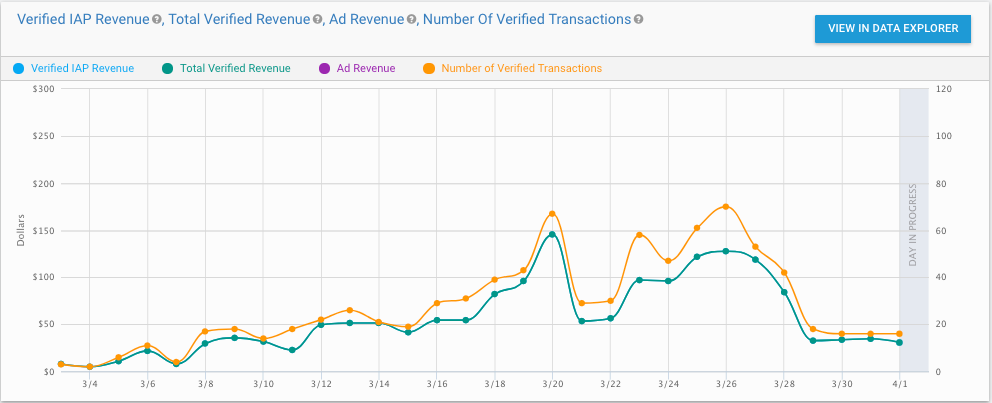
The first chart shows verified in-app purchase revenue and transactions and advertising revenue from the Unity Ads Service. The charts on the Overview tab only show verified IAP revenue, but you can view all reported revenue in the Data Explorer. Unverified revenue sources include test transactions, fraudulent transactions, transactions from platforms that do not support receipt verification (like Amazon and the Windows store), and transactions reported using missing or incorrect information or without configuring the required store API keys. When you use the Unity IAP Service, IAP transactions are automatically reported and verified. When you use an external IAP API, you can report and verify IAP revenue through the Unity Analytics API.
The second chart shows the daily averages of revenue per paying user and per active user:

Average Revenue Per Paying User (ARPPU) shows the average amount spent by those players who make IAP transactions on a given day. The Average Revenue Per Daily Active User (ARPDAU) shows the average revenue from all users and includes both IAP revenue and advertising revenue on a given day.
The overview charts show revenue for all users. To better understand how different groups of players monetize, use the Data Explorer to view revenue by segment. The standard segments include lifecycle cohort, geography, monetization category, demographics (when reported), and platform. You can also define your own segments.
The Data Explorer page of the Dashboard provides several additional monetization metrics and segments:
Monetization Metrics:
- ARPDAU (Average Revenue Per Daily Active User)
- ARPPU (Average revenue Per Paying User)
- Number of Unverified Transactions
- Number of Verified Transactions
- Total IAP Revenue
- Total Verified Revenue
- Unverified IAP Revenue
- Verified IAP Revenue
- Verified Paying Users
Ad Metrics:
- Ad ARPU (Average Revenue Per User)
- Ad Revenue
- Ad Starts
- Ads per DAU
- eCPM (estimated Cost Per Thousand Impressions)
Monetization Segments:
- Whales
- Dolphins
- Minnows
- Never Monetized
- All Spenders
See Monetization for more information about revenue analytics.
Data segmentation
Segments help you better understand player behavior. The standard, predefined segments group players by the following categories:
- Lifecycle – group players by the number of days since install. Lifecycle cohorts are useful for analyzing how player behavior changes with more experience in your application.
- Geography – group players by country.
- Monetization – group players by spending category. Monetization categories help you understand the behavior of players by how much revenue they generate.
- Platform – group by the player’s computer OS or device type.
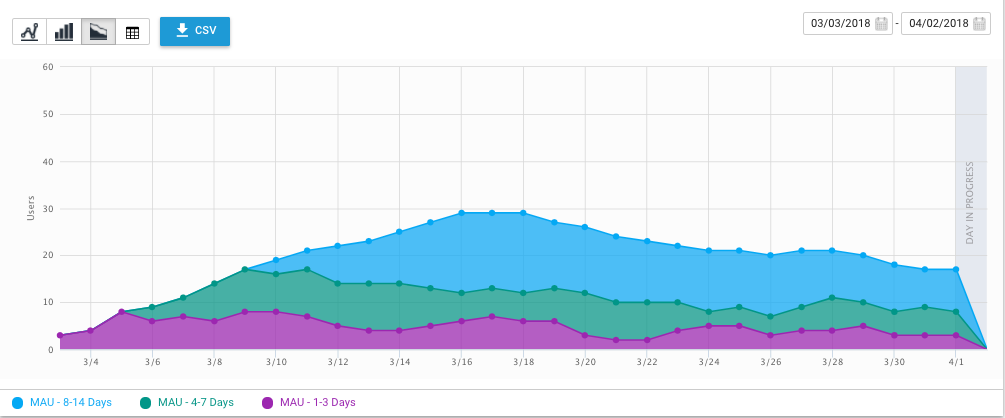
You can use the Segment Builder to define your own categories. However, you can only use any new categories that you make on data collected after those categories are created. For example, if you add a segment for players from Gibraltar, the segment is initially empty; only new activity from players in Gibraltar will show up in the segment.
You can use segments in the Data Explorer and Funnel reports.
For more information about creating your own segments, see Segment Builder.
Remote Settings
The Remote Settings feature allows you to change the values of variables in your games from your Analytics Dashboard. You can create any number of Remote Settings while developing your game and assign them to GameObject variables in the Editor. After launching your game, you can change the values of these variables at any time, allowing you to adapt game behavior without releasing an update.
You can use Remote Settings for tasks such as:
- Adjusting game-play tuning variables
- Enabling or disabling features
- Changing graphical themes
See Remote Settings for more information.
Heatmaps
Heatmaps visualize Analytics events spatially in your game.
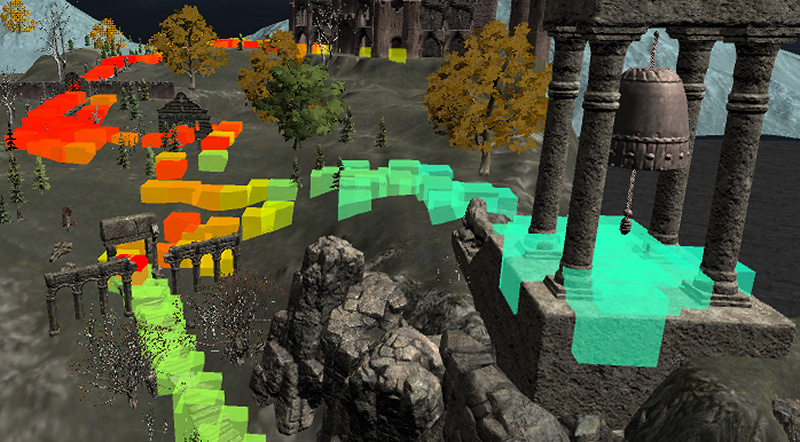
Use heatmaps while playtesting your game to identify performance and gameplay bottlenecks. Because they require a high volume of Analytics events, using heatmaps after your game has shipped and is in production is not supported.
See BitBucket documentation on Heatmaps for more information.
Heatmaps require Raw Data Export, which is only available with a Unity Pro subscription.
Accessing your raw data
When the reports available on the Analytics Dashboard don’t support the type of analysis you want to perform, you can export your analytics events using Raw Data Export. You can export data from the Analytics Dashboard or using the Raw Data Export REST API in either JSON or tab-separated-value format. From there, you can import the data into a database or analysis tool.
Raw Data Export requires a Unity-Pro subscription. See Raw Data Export for more information.
Supported platforms
The Unity Analytics Service supports the following platforms:
- iOS
- Android
- Tizen
- Windows Phone 8.1
- Windows Store 8.1 (Desktop)
- Windows Store 10.0 (Desktop)
- Mac, PC, Linux Standalone
- WebGL - для версий 5.3 и выше
2018–06–22 Page published with editorial review
New feature in Unity 2017.1
Removed Demographics section.